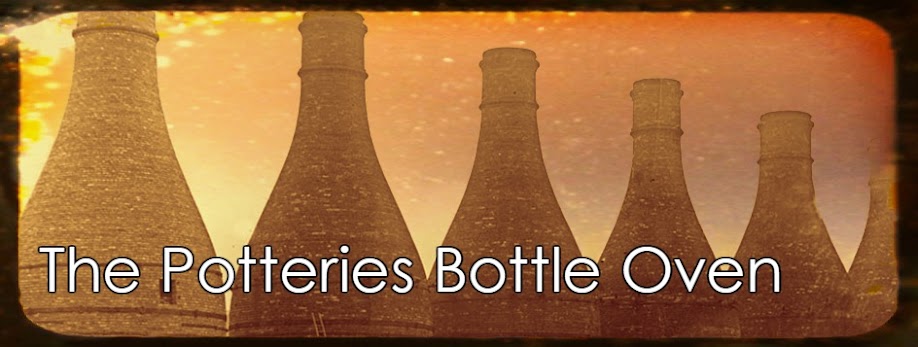Stoke-upon-Trent, also called just Stoke, or Stoke Town, is one of the six towns of the city of Stoke-on-Trent. The town was incorporated as a municipal borough in 1874 and is one of six (including Hanley, Tunstall, Burslem, Longton and Fenton) that federated to form the county borough of Stoke-on-Trent in 1910. It is the seat of the city's council, though Stoke-on-Trent's city centre is usually regarded as being the nearby Hanley. Stoke remained a small village until the 18th century when Josiah Spode and Thomas Minton established their potbanks.
BOTTLE OVENS LONG SINCE GONE
| Minton factory, London Road, Stoke. Trent and Mersey Canal in the middle Photo: Courtesy Staffordshire Past Track more here> Date: c1930 |
 |
| Minton Factory, London Road, looking towards Stoke centre Photo: source unknown Date: 1960s? |
 |
| Bottle ovens at Minton's factory Reginald G Haggar water colour painting Date: 1964 |
 |
| Minton's Factory, London Road, Stoke China biscuit bottle oven Watercolour by Reginald G Haggar, 1966 Photo: source unknown |
 |
| Minton factory, London Road. Photo: Courtesy Alan Gerrard Date: 1960s |
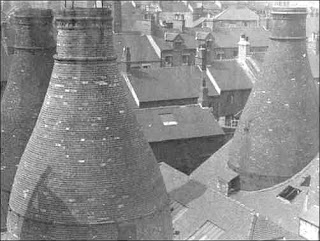 |
| Possibly Minton Factory Photo: source unknown Date: unknown |
| South Wolfe Street, looking towards the rear of Minton Factory Photo: source unknown Date: unknown |
 |
| J H Barratt & Co Boothen Tile Works Photo: source unknown Date: unknown |
Spode Works
https://spodehistory.blogspot.com/2018/07/spode-and-bottle-ovens.html
 |
| Spode Works Two paintings by Reginald G Haggar, late 1960s Photo: source unknown |
| Spode Works Updraught hob-mouthed bottle oven with hovel Hovel collapsed in March 1972 |
 |
| Spode Works Flint calcining kilns Photo: Robert Copeland Date: unknown |
 |
| Spode Works Flint kilns and stone bank Photo: unknown source. Date: 1957 |
 |
| Spode Works Photo: source unknown Date: Probably 1936 |
 |
| This Times newspaper article is dated 1960 but the image is very probably earlier. |
| Spode Works Muffle kiln demolition Photo: source unknown Date: 1938 |
 |
| Empire Porcelain Factory demolition Photo: source unknown Date: 1968 |
 |
| Twyfords in Garner Street. Photo: Source unknown Date 1950s |
| Twyfords Cliffe Vale Factory, Shelton New Road Photo: Source unknown Date: poss 1950s |
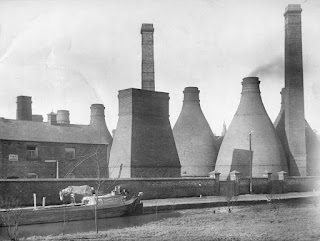 |
| Twyfords Cliffe Vale Factory, Shelton New Road Photo: unknown source Date: Unknown but possibly 1930s |
back to top>
BOTTLE OVENS and KILNS STILL STANDING, WITH THEIR CHIMNEYS
Falcon Works, Sturgess Street, ST4 7QH
[18a,b] Location* : what3words.com/paper.race.exit
Falcon Works formerly Goss China. Two biscuit updraught, stack, hob-mouthed ovens. Free-standing and enclosed within a building. In the 1976 the Bottle Oven Survey found the inside of the ovens to be clean and free from rubbish but the overall condition of these are now poor, particularly the stacks. 8 firemouths but no remaining firebars. Dampers include a central crown damper 18" diameter and three quarter dampers, All of the dampers themselves have been dismantled.
| Falcon Works, Sturgess Street Photo: Terry Woolliscroft Collection Date: 1975 |
 |
| Falcon Works, Sturgess Street Photo: source unknown Date: unknown |
 |
| Falcon Works, Sturgess Street Photos: Terry Woolliscroft Collection Date: April 1976 Taken during the Bottle Oven Survey 1976 |
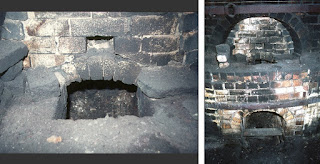 |
| Hob mouth on one of the bottle ovens at Falcon Works, Sturgess Street Photos: Terry Woolliscroft Collection Date: April 1976 taken during the Bottle Oven Survey more here> |
| Falcon Works. Former Goss Works, Sturgess Street. Photo: Courtesy of Philip Shallcross Collection Date: Feb 2019 |
| Falcon Works. Former Goss Works, Sturgess Street Photo: Courtesy of Philip Shallcross Collection Date: Feb 2019 |
| Falcon Works, Sturgess Street Photo: Gladstone Pottery Museum Collection, Courtesy Mr Phil Hewitt Date: 1973 |
Falcon Works on YouTube
https://youtu.be/_07a7UJOJuI
https://youtu.be/_07a7UJOJuI
Falcon Works on YouTube
Urban Exploring UK 2019
12 July 2022 - StokeOnTrentLive - Sentinel Headlines
Legal action to be taken against owner of arson-hit potbank. The Falcon Works in Stoke was again set ablaze at the weekend. Article by Phil Corrigan
Dolby Flint Mill, Lytton Street, ST4 2AG
[17a] Location* : what3words.com/trials.spike.live
Former Dolby Potters Millers, Lytton Street Stoke. Free standing flint calcining kiln, with square base to hovel, rising to oval and then cylindrical top. Built by 1937. Now stands within garage, adjacent to Trent & Mersey Canal. Two adjacent firing chambers within one structure with single stack. Recorded in Bottle Oven survey of 1976
Cliffe Vale Works, Twyfords, Shelton New Road, ST4 7AL
[15a,b] Location* : what3words.com/singer.churn.still
Two flint calcining kilns.
05 September 2023 - StokeOnTrentLive - Sentinel Headlines - Plan to transform arson-hit former Stoke pottery into posh townhouses
New plans have been lodged to convert an arson-hit former pottery - with developers now bidding to transform the historic factory into townhouses. A previous proposal to turn the Grade II Listed Falcon Works in Stoke into more than 80 flats was rejected by Stoke-on-Trent City Council back in October 2022. Lack of affordable housing and failure to preserve the character of the building were cited as reasons for the refusal. Article by Gary Porter
Dolby Flint Mill, Lytton Street, ST4 2AG
[17a] Location* : what3words.com/trials.spike.live
Former Dolby Potters Millers, Lytton Street Stoke. Free standing flint calcining kiln, with square base to hovel, rising to oval and then cylindrical top. Built by 1937. Now stands within garage, adjacent to Trent & Mersey Canal. Two adjacent firing chambers within one structure with single stack. Recorded in Bottle Oven survey of 1976
| Dolby Mill, Lytton Street Calcining kiln with two chambers and one chimney stack, Photo: Terry Woolliscroft Date: 1975 |
| Dolby Potters Millers & Merchants, Lytton Street Photo: Courtesy of Philip Shallcross Collection Date: April 2019 |
 |
| Dolbys Mill Photo: source unknown Date: 1960s |
Cliffe Vale Works, Twyfords, Shelton New Road, ST4 7AL
[15a,b] Location* : what3words.com/singer.churn.still
Two flint calcining kilns.
"Pottery works and bottle ovens. 1887 with later modifications. Brick with stone dressings and plain tiled roofs. Frontage range of 3 storeys and 22 bays (2-2-4-1-4-9). Entrance bay has stone pilasters and entrance with cast-iron lintel over and 3 stilted arched windows above, and ornamented segmental pediment bearing date. Flanking this entrance bay are 2 towers with paired windows with stone aprons in the upper floors, and stone quoins. The outer range to the right has giant arched colonnade with windows with cambered brick heads, and moulded brick eaves cornice. 2 bays to the left in a similar style, then a gabled range with giant brick arches. 2 calcining kilns of circular section joined together at base, but with free-standing caps". Now part of a housing development.
 |
| Twyfords Factory, Shelton New Road, Cliffe Vale Flint calcining kilns Photos: Courtesy of 'Potteries Bottle Kilns' page on Facebook Date: 2015 |
The following text about calcining kilns is from "HISTORY OF TWYFORDS ALSAGER FACTORY, IT'S BUILDING AND DEVELOPMENT" Unknown author. Date around 1980.
"To soften flints to enable them to be easier crushed and milled they are heated to a temperature of around 750C before being passed through crushers, granulators, etc., to a particle size of about 0.5". These flints were calcined in calcining kilns at Cliffe Vale, 3 in number. Two of these kilns are still standing and are similar in outline to a bottle kiln, the third much narrower in section was demolished in the 1960s. The flints to be calcined were placed in layers between layer of coal in the kiln and the whole rested on a bed of wood which was burnt to get the coal burning. About 70 tons of flints were calcined in each kiln and the process took about 4 days.
The smoke and fumes given off from the calcining kilns added to the smoke and fumes given off from the bottle ovens firing ware, and the intermittent kilns firing fireclay, and the calcining kilns due to the obnoxious fumes given off from them became the responsibility of the Alkali Division of the Factory Inspectorate who indicated that the calcination of flints by coal had to cease. Experiments were tried using coke. These were successful but with the coming of Natural Gas and the fading out of Gas Works carbonising plants that produced coke, it was clear that other methods had to be used.
In 1971 two calcining kilns, gas fired, were put to work at the Alsager factory. There was no crushing plant or mill at Alsager at this time and the calcined flints were taken back to Cliffe Vale where a hole was cut into the side of one of the calcining kilns at Cliffe Vale. The calcined flints from Alsager were tipped into this kiln and so they began their normal production flow pattern to the ball mills. During 1979 a preservation order was placed on the two calcining kilns at Cliffe Vale by the Department of the Environment. This order does not allow for the demolition of the kilns without the department's permission and is a means of preserving the heritage of the Industry."
 |
| Twyfords Factory, Shelton New Road, Cliffe Vale Photo: source unknown Date: Mid 1960s |
| Twyford's Cliffe Vale Works, flint calcining kilns Photo: Courtesy of Philip Shallcross Collection Date: March 2019 |
 |
| Twyford's Cliffe Vale Works, flint calcining kilns Photo: source unknown Date: late 1950s |
BOTTLE OVEN REMAINS WITHOUT THE HOVEL
Spode Works, Church Street/Elenora Street, ST4 1BS
[16a] Location* : what3words.com/maple.split.pays
Updraught hovel bottle oven. The hovel chimney collapsed in 1972. Now (2022) only the lower part of the firing chamber remains. Important hob-mouthed firemouths.
Updraught hovel bottle oven. The hovel chimney collapsed in 1972. Now (2022) only the lower part of the firing chamber remains. Important hob-mouthed firemouths.
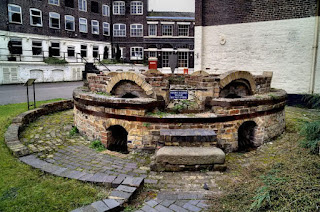 |
| Spode bottle oven, firing chamber base remains in 2019 clearly shows the clammins and hob-mouthed firemouths |
This factory was purchased by Spode I & Spode II in 1776 (some say, incorrectly, 1770). The company went into administration in 2008 and closed in 2009. The Spode 'brand' was then purchased by Portmeirion Ltd in 2009. Parts of the factory site are now owned by Stoke city council. The bottle oven which survives as a ruin is a hob-mouthed, updraught, hovel bottle oven.
| Spode updraught hob-mouthed bottle oven with its hovel before it collapsed in March 1972 |
"It was in 1960 that the last firing of a bottle oven on the Spode Works took place. It was a china biscuit oven - that is, the bone china clay-ware was fired to about 1260°C to the 'biscuit' stage." Extract from: Manufacturing Processes of Tableware during the Eighteenth & Nineteenth Centuries by Robert Copeland 2009
SPODE OVEN COLLAPSES
The base of one oven survives (in 2019) on the site of the former Spode factory. Robert Copeland described when it became a 'ruin'. "1972" he said, "March. It was a Friday. About 2pm. There was a loud whoosh and the hovel of the bottle oven collapsed as I walked nearby."
 |
| Spode bottle oven hovel collapsed March 1972 |
 |
| Bottle oven hovel, collapsed March 1972 |
